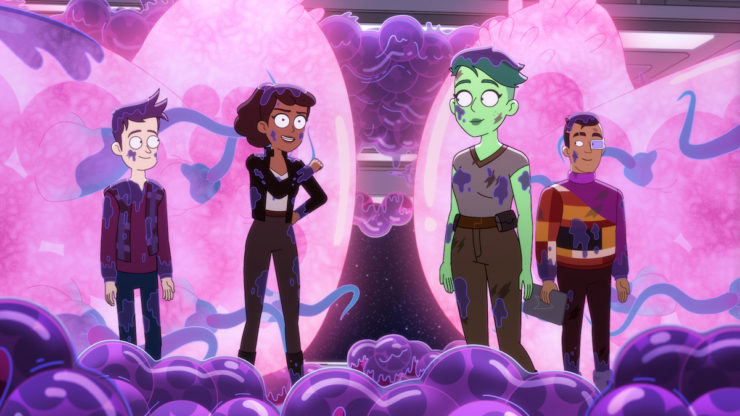The third season of Lower Decks has continued the good work the second season started in correcting many of the issues the first season had, and doing interesting things with the characters. Mariner and Rutherford in particular have strong narrative arcs that develop their characters nicely, while Boimler and Tendi do more to channel their inner badasses.
Plus there are a lot more direct ties to other Trek series, with some wonderful guest voices.
Having done the good, the bad, and the ugly for the hit-and-miss season one, and the good, the bad, and the awesome for the much better season two, this time around we’re going with the good, the bad, and the interesting, as this season more than the other two has some food for thought…
The Good
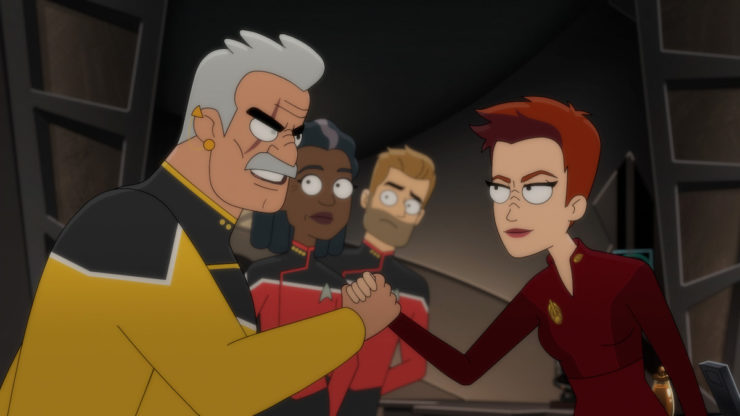
In general, there was a fun use of past Trek characters. Having had Q and Borg Queen cameos, guest appearances by Riker, Troi, Paris, and Gomez, they went whole hog this season, with appearances by versions of Zefram Cochrane (James Cromwell), Leah Brahms (Susan Gibney), Chancellor Martok (J.G. Hertzler), and Captain Sulu (George Takei), quick visual cameos by Captain Morgan Bateson and Tuvok of Vulcan, and guest appearances by Colonel Kira (Nana Visitor) and Quark (Armin Shimerman).
Those last two are a big part of my favorite episode of the season, and one of the best, “Hear All, Trust Nothing,” which is totally a love letter to DS9 but also a good story, one that makes use of the Karemma from that show and gives us a hint of what life is like in the Bajoran system six years after the Dominion War.
We get an actual character arc for Mariner this season, starting in “Grounded” with her stubborn insistence on trying to be the prototypical action movie hero who bucks the system and gets shit done in order to save her mother from being convicted of a crime she didn’t commit—which proves utterly unnecessary, because Freeman is, instead, exonerated by the system actually working. Mariner then spends a lot of the season being supervised by Ransom, which does actually do her some good. But then when Cerritos is the subject of a journalistic hatchet job by FNN in “Trusted Sources,” Mariner is blamed, even though it turns out she was the only one who said nice things about the ship. She quits, she realizes that playing Indiana Jones to Petra Aberdeen’s Lara Croft isn’t for her, and she rejoins the Cerritos crew, hopefully a better person, in “The Stars at Night.” This is exactly the kind of character growth that Mariner needed in order to continue to be a viable character, because first-season Mariner was too much of a fuckup to be able to last on a Starfleet ship, even one as goofy as this…
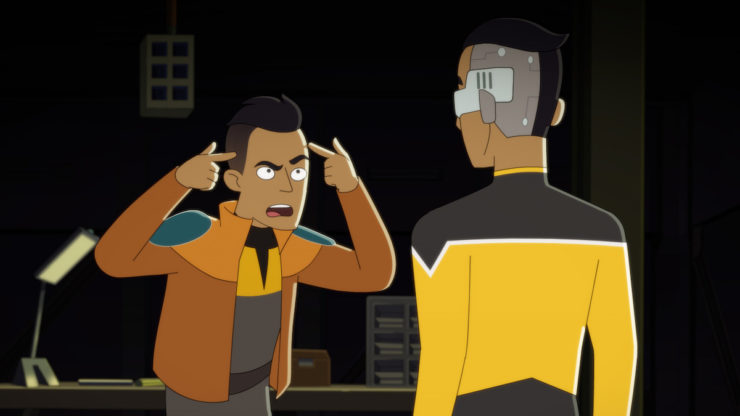
In addition, we get some wonderful stuff with Rutherford. The hints dropped back in “First First Contact” are all resolved, as we find out why Rutherford really got his cybernetic implants, and why his memories were altered. Plus, we find out what Rutherford was like before the accident—basically, he was a self-centered asshole—and he’s much better now as the lovable dork we’ve come to know and love, even if it happened for a terrible reason.
Tendi starts her training to become a bridge officer, and also gets to show off her badassery again, while Boimler also embraces the greater confidence he’s gotten over the course of the series to become “Bold Boimler” who does the crazy-ass shit. Sometimes this backfires—like when he loses his shit at a recruitment fair—but sometimes it’s useful—like when he makes the bridge crew realize that Shaxs’ repeated desire to eject the warp core will actually work this time. But either way, watching Boimler’s growth has been fabulous.
Bozeman, Montana being a First Contact theme park was just epic. So were the Klingon Klowns. So is the developing relationship between Shaxs and T’Ana.
The Bad
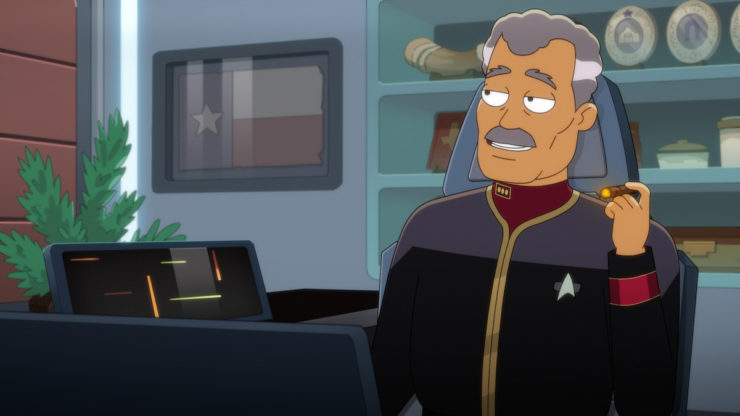
NOT ENOUGH KIMOLU AND MATT! Seriously, they’re, like, the best characters ever, and they only got two quick cameos. Feh.
Now that I’ve had a week to think about it, I find that I don’t like the LD version of the Evil Admiral Cliché. Having Buenamigo manipulate the Cerritos into failure—first at Deep Space 9, then at Ornara and Brekka—was fine, but it’s when he turned homicidal that I started to have issues. The only other evil admiral who’d actually tried to destroy a Starfleet vessel was Leyton on DS9, and he had the excuse of the Federation being on the brink of war. In general, most of the evil admirals have had their motives in the right place. Buenamigo just wanted to get noticed more, and that level of selfishness just didn’t fly for me given the extremity of his actions.
Speaking of poor behavior, there’s the sniping between Freeman and Captain Maier of the Carlsbad in “Mining the Mind’s Mines,” which didn’t work for me at all. As I’ve said, y’know, a lot, this show works so much better when it’s a humorous Trek show, not a twenty-first-century sitcom sledgehammered into Trek. The immature sniping we saw between the two captains was a sitcom plot, and the show is better serviced by doing funny Trek plots.
The journalist we met in “Trusted Sources” is the worst cliché of a contemporary television journalist, and ruins what should’ve been an important episode for the Cerritos crew in general and the characters of Freeman and Mariner in particular. She manipulates the facts, she comes across immediately as a ditz, and her story is slanted. (It doesn’t help that the franchise has a pretty crappy history with portraying journalists in general, as we got this same lazy storytelling in Generations and Picard.)
The cabin lottery rigging race between Beta and Delta shifts in “Room for Growth” was pretty much wrong on every level.
Kayshon has been speaking in Tamarian metaphor a bit more, but mostly this character has continued to be a wasted opportunity.
NOT ENOUGH KIMOULU AND MATT! Did I mention that already?
The Interesting
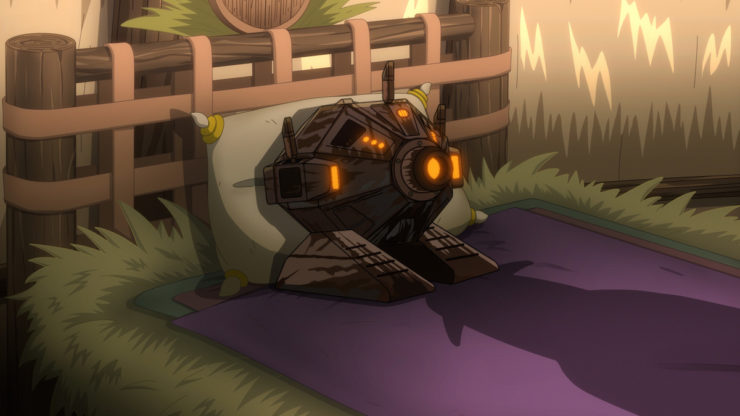
While I don’t think the episode as presented was entirely successful, I admire the fact that LD was willing to break the format up a bit and give us an entire episode centered on Kether Donohue’s Peanut Hamper. And the reasons why the episode didn’t work weren’t because the show broke format. I’d love to see more storytelling risks being taken.
On the one hand, I’m glad they haven’t just forgotten about Boimler’s transporter twin on the Titan. On the other hand, he’s apparently joining Section 31, which means that the worst, most contemptible, most un-Trek-like thing to be created in the Trek universe has now shown up in four different series (as well as one movie), and I’m really tired of it and want it to go away. But I’m also willing to give LD the benefit of the doubt, because if any show will portray 31 as garbage, it might be this one…
One of the dichotomies this show has had to face is the desire for a big-ass climax to end the season, which is at odds with its mandate as the show that focuses on the belowdecks personnel. “A Mathematically Perfect Redemption” and “The Stars at Night” contrived to put Boimler, Mariner, Tendi, and Rutherford on the bridge because that’s where the action is, and yet it contravenes the whole point of the show to have them regularly having bridge duty. “Grounded” did a much better job of this, having Mariner and the gang doing their thing while the good stuff all happens off-camera.
I almost put this part in the “bad” section, but I’m taking a wait-and-see approach: I was really looking forward to seeing the relationship between Mariner and Jennifer develop, and it, well didn’t. There was anxiety in “Mining the Mind’s Mines,” there was bonding over tormenting her pretentious friends in “Hear All, Trust Nothing,” and then Jennifer took everyone’s side against Mariner in “Trusted Sources,” and then it wasn’t resolved at all in “The Stars at Night.” I’m hoping we see more of these two crazy kids in season four, and see what impact Jennifer’s willingness to believe the worst of Mariner has (if any—after all, Mariner’s own mother and best friends also believed the worst, and Mariner forgave them…). If we don’t, then it was a totally botched storyline.
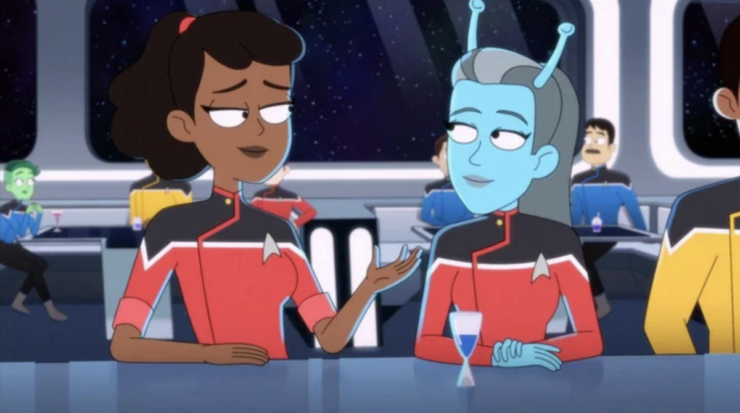
The series has settled down into a fun show. The characters have actually been progressing, which is great to see, and they only occasionally devolve into dumb stuff. I have become invested in everyone on board—not just our four main characters, but even the bridge crew, all of whom have become more interesting and complex as the show goes on. This is turning into a, like, real Star Trek show and stuff!
And there’s lots of stuff set up for next season, from Boimler’s twin joining Section 31 to the potential evil-AI team-up between AGIMUS and Peanut Hamper to whatever that was with Badgey in the post-credits scene of “The Stars at Night.”
Keith R.A. DeCandido is going to be writing one of the four novellas in Sherlock Holmes: Cases by Candlelight Volume 2, which will be released next summer. The other contributors include fellow Trek scribes Michael Jan Friedman and Aaron Rosenberg, as well as renowned Holmes scribe Christopher D. Abbott. Here’s a preorder link for the Kindle edition.










